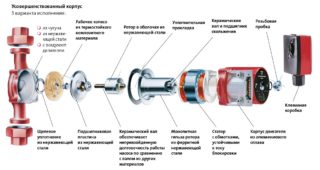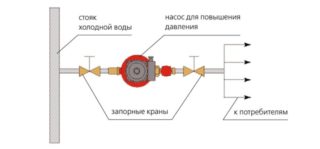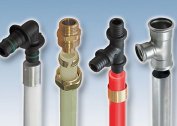If the water supply comes from the central water supply network, a sharp drop in pressure in the pipelines during maximum consumption is possible. As a result, the instantaneous water heater does not turn on, the washing machine does not work, and water flows from the shower head into a thin stream. Fix the situation will allow the installation of a booster pump.
Scope of application
A pump for pumping water from a water supply is used not only in apartments, but also in a private house, if it is connected to a centralized network. In the process of active water intake by all consumers in the external circuit of the water main, the pressure decreases to less than two atmospheres. To operate household appliances is almost impossible. To increase the pressure, pumping equipment is used for cold or hot water supply. The type of unit is indicated in the accompanying documentation.
Booster pump units are also used in individual and central heating systems, which allows to improve the heating qualities of heating devices.
The device of pumping equipment
Booster pumps are robust designs with a single-block electric motor. Since the parts of the feed unit are constantly in contact with the aquatic environment, wear-resistant materials that are not afraid of rust are used for production: cast iron, bronze, brass, and stainless steel. The working part of the pump is open only on one side. The front suction bell is located above the apparatus shaft, and a feeding bell element is installed above it.
Almost all devices for raising the pressure of the water flow are small in size, which makes it possible to easily install them directly on the pipeline in a spacious private house or in a small apartment. The device is mounted in a water distribution and pumps water, creating an increase in pressure by 1-3 atm.
Elevators only slightly increase the pressure in the water supply, but even this minimum will ensure the full operation of household appliances.
The temperature range of water for effective operation of the pump is from 10 to 100 degrees heat, but the room should not be warmer than 40 degrees.
Not always the installation of pumping equipment solves the pressure problem. If the neighbors below installed such a device, the water flow will be weak due to lack of fluid, and your pumping equipment will work at maximum load. There is a risk of premature wear of parts and a decrease in the operational period. To save the pump and increase the pressure, it is recommended to additionally mount storage tanks.
Mechanism of action
The principle of operation depends on the type of installation:
- jet centrifugal;
- surface centrifugal;
- vortex.
The first type has an ejector inside the casing, which provides a self-priming effect. Part of the water that the device pumps is delivered to the discharge pipe. Recirculation of the remaining liquid is carried out using an ejector, which allows you to create a vacuum inside the suction compartment, which leads to an increase in pressure.
The devices of the second type are equipped with a special working chamber necessary for the absorption of liquid. It is equipped with an impeller consisting of parallel rims. These parts are bonded to each other. Water flow falls on the blades, leans back to the walls of the chamber and collects in the channel. The strength of the water flow is converted into pressure energy, which leads to increased pressure.
In vortex installations on the working shaft there is an impeller, and on it there are radial blades for transmitting mechanical energy of the pumped liquid. Thanks to them, the incoming water is recycled. Numerous blades facilitate the transfer of energy, which leads to a gradual increase in fluid flow and its maintenance at a high level. Such units are more productive, but noisy, and they need a special harness.
Types of pumps
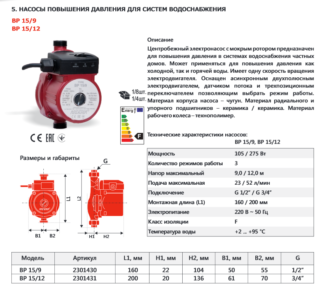 Devices are classified not only by the way they work, but also by the type of cooling. Models with a dry rotor are productive, but noisy and dimensional. Wet rotor pumping devices for home piping are preferred. They are small and virtually silent.
Devices are classified not only by the way they work, but also by the type of cooling. Models with a dry rotor are productive, but noisy and dimensional. Wet rotor pumping devices for home piping are preferred. They are small and virtually silent.
According to the installation method, the models can be:
- horizontal
- vertical
- universal.
The pump for raising the pressure in the water supply, installed vertically, gives the highest efficiency when used.
Units can be single-stage, that is, operate at the same pumping speed, and multi-stage. The latter work with different intensities, depending on the amount of water flow. Multistage models allow you to smoothly increase the pressure in the network.
The device turns on manually or using automation. With manual control, the device operates continuously, the stop is forced by the user. The inconvenience is the need to ensure that the device does not overheat.
Automatic devices are equipped with flow sensors that trigger when the valve opens and start the device. After shutting off the water through a tap, the sensor turns off the device. There are also combined options that, thanks to the transfer of the switch, function in one or the other mode.
Criterias of choice
Before buying a device, make sure that problems with lack of water in taps are associated with low pressure. It happens that on the inner surfaces of the highway there is a thick layer of sediment or blockage is created. In such a situation, the use of the device is useless.
If everything is fine with the pipeline, determine the installation location of the device in order to correctly select the dimensions of the equipment and its type. Booster pumps for cold water should not be installed on hot lines.
The choice of device depends not only on temperature characteristics, but also on such indicators:
- performance;
- power;
- noise level;
- connection method to the water supply network;
- bandwidth.
Focus on what the impeller is made of. Devices with a plastic part are short-lived, suitable only for summer cottages. Permanent use requires a brass or bronze mechanism.
An important indicator is the price of the unit. It depends on the type, power of the device, manufacturer. The cost of Grundfos appliances starts at 6,800 rubles, Dzhileks - from 4,500 rubles, Oasis - from 3,500 rubles, Vodok - from 2,900 rubles, Comfort - from 2,170 rubles.
Features of installation and connection
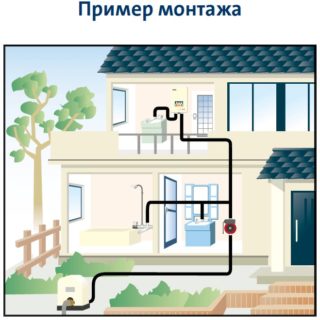 When mounting the device on a common pipeline, the pressure will increase in all sections of the water supply at home. Due to the large area, the efficiency of the device will be minimal. In particular, if the water intake is carried out simultaneously from several points.
When mounting the device on a common pipeline, the pressure will increase in all sections of the water supply at home. Due to the large area, the efficiency of the device will be minimal. In particular, if the water intake is carried out simultaneously from several points.
Installation of a high-power device is not beneficial in terms of power consumption and noise.
The best option is to equip the device in front of a consumer who needs constant pressure. If necessary, mount several low-power budget installations.
For each case, the length of the pipe segments is measured, their diameter, pressure level. This helps determine the appropriate device settings.
The installation scheme does not differ in complexity:
- Make sure that when installing in the selected location, it is possible to connect the device to the power supply.
- Mark the place of the insert.
- Block the water flow and drain the remaining fluid from the water supply.
- Cut the pipe and install the external thread.
- Screw adapters and screw fittings.
- Connect the appliance to the electrical panel using a three-wire cable. In this case, a separate machine must be installed for the pump.
- Check connections for leaks.
Next, you can begin to conduct test tests. The first start-up of the device is carried out only after the resumption of circulation of the water stream. If the tests are carried out by specialists, they draw up the act of checking booster pumps.
Pumping units can cope with low water pressure. But for maximum effectiveness, it is necessary to choose the right model and install the device. To monitor the technical condition of the device, you will need to choose an easily accessible place for its installation.
